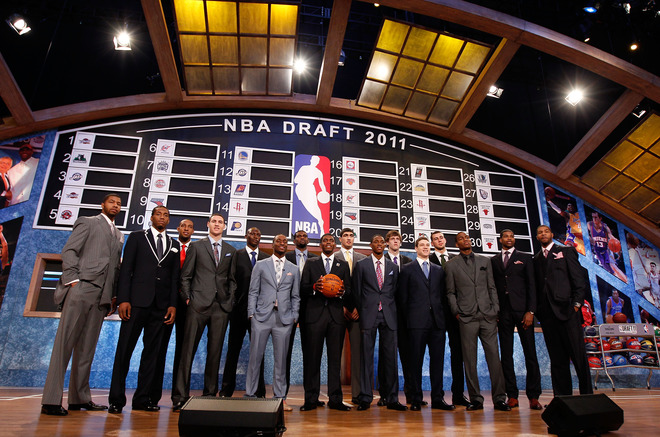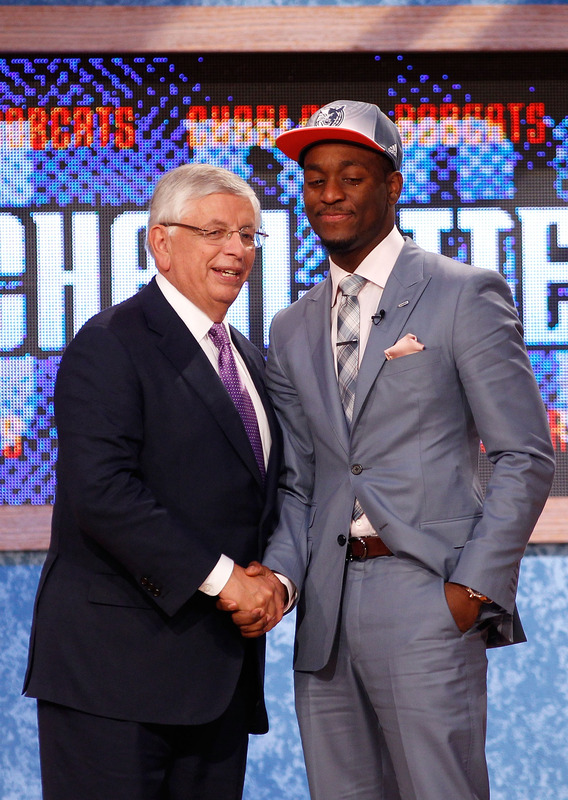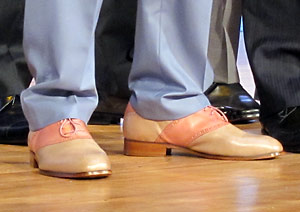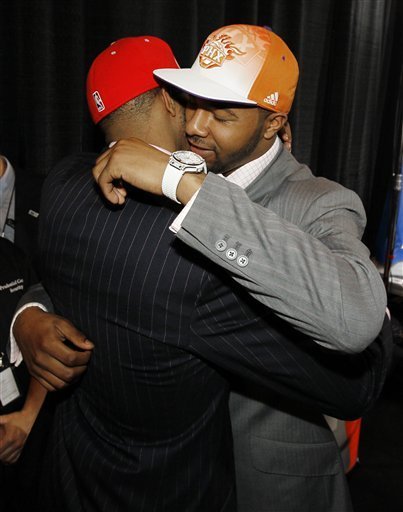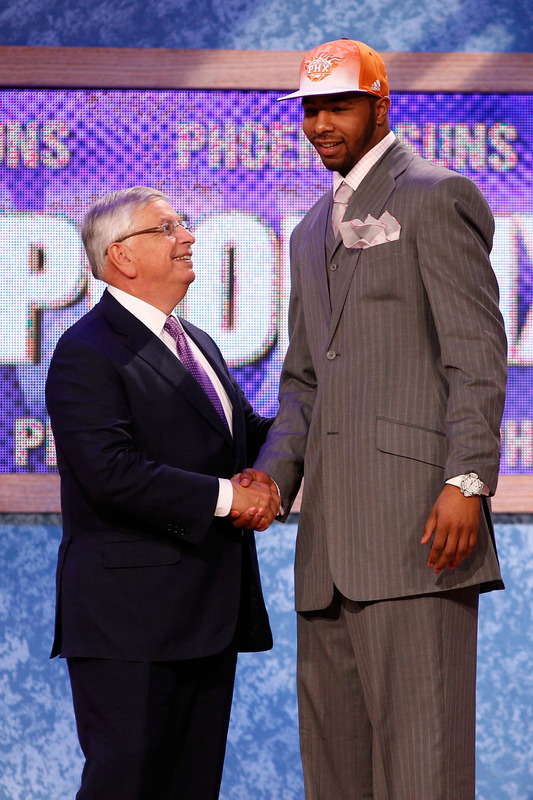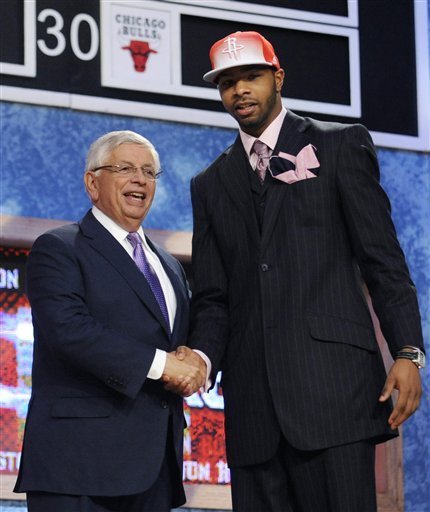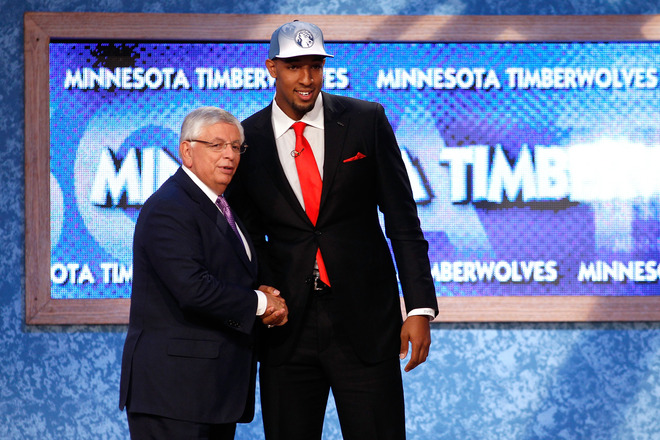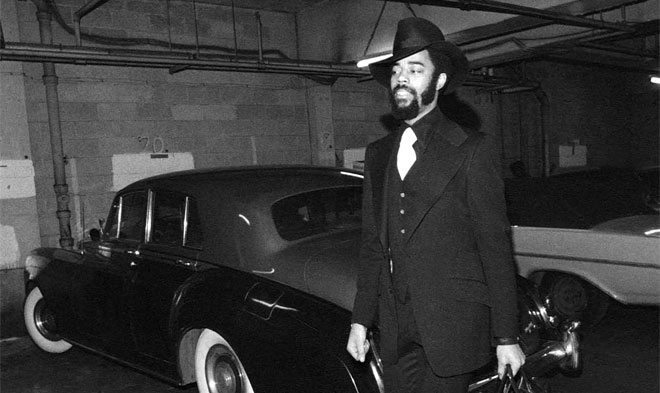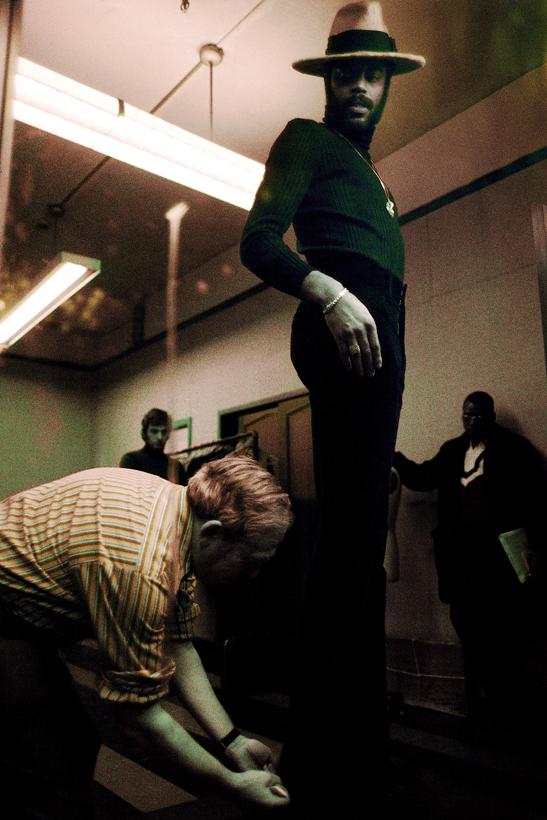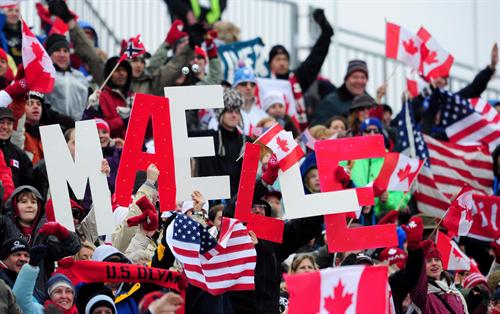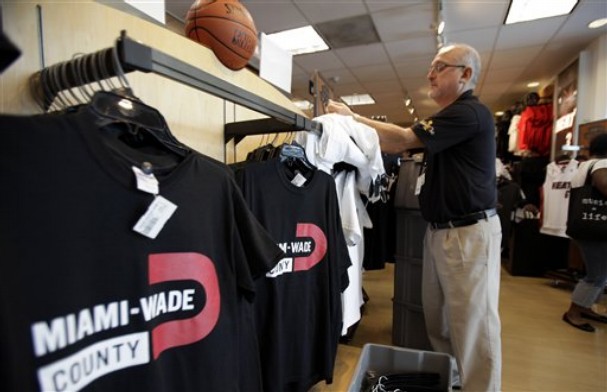
High Fashion on the Field: Dolce and Gabbana Extend Deal with Azzuri
When it comes to professional sports, you often see high fashion brands on the backs of athletes off the field but never during game play. However, it should come as no surprise that soccer (or football, out of North America) is the first sport to really embrace fashion on the field. Many soccer players in Europe have modeled for brands,have enviable closets that resemble high-end boutiques and are often credited for bringing the slim, slick suits to the sporting world. Only in recent years have North American athletes began adopting the "Euro" style of dress and swagger.
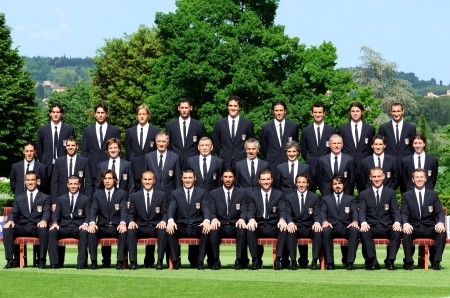
Today, Dolce and Gabbana announced that they would be extending their deal with the Italian national soccer team through 2014. The Italian fashion house will begin designing kits for the men's senior team for the qualifications of the 2012 UEFA European Championships as well as the Under-21 squad. The collaboration originally started in 2006 after the men's national team (also known as Azzuri) won their fourth World Cup. Dolce and Gabbana's old deal had them dressing the Italian athletes in suits for pre and post game, but not on field. Azzuri's previous jersey outfitter was German sports brand Puma. 2014 is a significant year as it marks the next FIFA World Cup in Brazil. Italy will be trying to capture their fifth World Cup after falling short of defending their title in 2010.
The Italian national team isn't D&G's first foray into soccer sponsorship. They sponsor local Serie A squad AC Milan and they've also been clothing the Milano Beach Soccer Club since 2008. D&G also produced a book dedicated to the players of AC Milan appropriately titled Milan Fashion Soccer Players Portraits this past May and have used athletes for underwear advertising editorials.
What team or sport will we next see embracing high fashion on the field? Stella McCartney designs tennis gear for adidas and the Williams sister ae known for pushing the boundaries of costume attire with their on-court attire with Nike. Fashion often takes cues from sport using football pads as armour for models and varsity jackets are now synonymous with streetwear. Rafael Nadal has stripped down to model for Emporio Armani while Dwyane Wade is collaborating on watch collections - sports and fashion are no longer odd bed fellows but frequent collaborators.
2011 NBA Draft Style Analysis: The Suits Finally Fit and Kemba is King
The 2011 installment of the NBA Draft was not given the opportunity to be great. Madison Square Garden, the usual host for festivities, is under renovation so the hopeful rookies had to travel across the Hudson River to Newark and walk the stage at Prudential Center. Bloggers and basketball pundits dismissed the next class of NBA talent as bottom tier. Also, with a lockout looming - will these young men ever see playing time? In 2003, LeBron James' oversized white ensemble was better suited for a pimp and not the first overall draft pick. His personal style has evolved thanks in part to the dress code, maturity and careful image management. The NBA instituted the dress code in 2005 and it came at the perfect time as menswear was moving towards to the skinny suit and tailored styles thanks to Hedi Slimane at Dior Homme. Fitted or "European" styles began dominating locker rooms along with luxury sneakers and Louis Vuitton everything. Braids began disappearing as Carmelo Anthony shaved his off and Kobe Bryant switched from jerseys pre-game to suits. Players no longer wanted to look like Allen Iverson but now Kanye West's fashion forward style evolution was to be mimicked. This year's draft class may not have hit the perfect style notes but it's clear that with the help of stylists, the new kids are learning how important fit is in a suit. Gone are the days of the LeBron white suit or Jalen Rose's infamous red atrocity. Without further ado, here's the best, worst and downright average style grades for the 2011 NBA draft class. It should come as no surprise that a New York kid wins my award for best dressed. Kemba Walker won my respect and fashion gold star last night because he wore a suit that was not only perfectly cut for his body type but because he was able to still let his personal style shine through. Last year, Wesley Johnson's plaid pants and double-breasted ensemble may have been sartorially inclined but it looked like the outfit wore him, not the other way around. Walker looked both comfortable and cool in the single breasted blue-grey suit. The peaked lapels were in proportion with his shoulders and the jacket was modern without being fussy. Walker was already on my radar for his understated, well-fitting suit at Connecticut's visit with President Obama after winning the NCAA National Championship. His big heart and great speaking skills makes him a complete player off the court as well - he's a marketing dream. In fact, he already has endorsement deals in place with Axe and Best Buy without the elusive title of being the number one draft pick. Walker's accessory choices elevated his look from above average to exquisite. The pocket square in beige with a pink hue picked up the rose gold outsole of his two-tone shoes. The tie bar kept his look clean but added some visual interest on his thin, patterned tie. Even his belt was a leather with a pink undertone to tie it all together. Fellas, when I say the items of your outfit don't have to match but they have to go, I'm talking about putting an ensemble together like Walker's. The hues (underlying color) are all in the same family - blue in the primary items and pink in the accessories. Since the colors are all related, they work in harmony. I'm excited to see what Walker brings to Charlotte off the court. According to my favorite Bobcats' source, Ben Swanson (a.k.a. CardboardGerald), the rookie came to the press conference dressed to impress in Louis Vuitton sneakers. Kemba Walker, you're on my fashion radar. He's my early pick for style rookie for the season....if we get a season.
Walker's swag dominated the night but credit has to be given both to my Canadian countryman Tristan Thompson, as well as Marshon Brooks for sporting full ensembles not just a suit. Thompson (and his personal shopper) found a suit that managed to fit him perfectly without looking snug in the shoulders or short in the sleeves - an issue for a player with a seven feet, two-inch wingspan.The polka dot tie contrasts with the pink tone in the shirt and the paisley pocket square ties it all together.His rose gold watch face is the right shade for his skin tone and the leather watch strap and shoes are the perfect complimentary shade of warm saddle brown - this is how to wear black and brown together. It certainly looked like Thompson dressed to best match his new Cavaliers cap - think he knew something the media didn't?
In every draft class, there seems to be one player that calls dibs on the bow tie and tries to make it work for him. This year, Marshon Brooks took the honor. The last time a bow tie was worn properly was when James Harden sported his cream ensemble and has since had the neck accessory a signature. Brooks seems to be following Harden's sartorial example. Brooks was originally drafted by the Celtics before being moved to the Nets, sported another bow tie at his introductory press conference in Newark. For draft night, his two piece grey suit fit in the shoulders and the sleeve length was fine although it could be taken in more in the torso and in arm width to remove some of the bulk - the ill fit was made obvious when he stood up to meet Commissioner Stern. Besides the technical suiting issues, the patterned shirt mixed with the neutral grey suit really make the bow tie the star to the outfit. A good tactic to draw attention up to Brooks' face and away from the terrible adidas draft caps.
The number one pick in the 2011 NBA Draft was Kyrie Irving out of Duke University and the only thing that streamed first overall about his outfit was his timepiece.Besides the impressive watch, the rest of ensemble was average - decent fitting jacket and shirt, pants could be tailored and the tie was too skinny and poorly knotted. Hopefully fellow rookie Tristan Thompson and veteran NBA fashion plate Baron Davis can help their new teammate take some risks this season.
Speaking of sartorial risks, Kawhi Leonard went for preppy throwback look with white piping on black two button suit. When I originally saw this suit, I immediately thought he belonged on a yacht or perhaps parking cars at the yacht club. The buttons are a bit distracting and the pocket square seems like an afterthought but the piping has grown on me. Keeping the shirt and tie relatively neutral was a smart move so it didn't distract from the jacket. The fit is decent, but as with many of these young men, the sleeve could be slimmed down. A pop of color or sheen in the pocket square could have upgraded the look and he might want to re-think the braids - no one should take manscaping cues from Udonis Haslem.
Pocket squares have become the new accessory of choice for NBA draftees in recent years and this year, some players either didn't put enough thought into them (Leonard) or tried too damn hard. It's important to remember that for these young men, most of their interviews will head and shoulder shots so the pocket square will be shown and having one that looks like a used tissue stuffed in your pocket looks sloppy. The Morris brothers were a great story of the draft, twins going one right after another to different cities for the first time in their young lives. But they had me crying foul all over Twitter as with the pocket square, bigger is not necessarily better as you have a limited space to display your accessory.
Markieff Morris, the slightly older twin and the first to be drafted, thirteenth overall to the Suns, wore a pinstripe suite that looked be right off the rack and ill-fitting on his massive frame. The jacket is too long, the shoulder are bunching and sleeves and pants must be taken in. Also, on a large man a three-piece suit adds bulk, he should have gone for a sleeker silhouette. As for the pocket square, it looks like he found some iridescent Kleenex and stuffed it in his pocket. The fact that you actually see a bulge from the access fabric in the jacket is a terrible look. Remember, it's a square, not a scarf. While we're on accessories, white watches, like white sunglasses, often just look cheap and it does not work with his outfit at all.
Marcus Morris, the younger brother by seven minutes, was drafted next to another Western Conference team, the Houston Rockets. Marcus, followed suit almost literally with a pinstripe three-piece suit in black that was looked to fit in the shoulders but not so well elsewhere. Not to be outdone by his brother, upped the pocket square ante as his almost reached his tie knot - far too large. I'm all for flair but the pocket square took over his entire outfit and you became distracted by his accessory and not listen to what the newly minted rookie had to say. Also, if you look the Morris' brothers wore similar shirt and ties. The best moment from the twin's draft came from their interview with their mother, who was also in a pinstripe suit, who said she wouldn't wear either of the adidas draft caps - smart woman.
As for the rest of the draft class, it was nice to see the players put some effort into their attire, the recent explosion of athlete stylists are certainly helping keep the players current. Derrick Williams tried to work with a skinny suit silhouette but didn't make it. The tailoring was fine but the tie knot didn't work with the shirt or the tie width. The bright red tie was a nice burst of color, but some more texture would have really made Williams stand out.
Jimmer Fredette came into the draft with plenty of hype thanks to his ridiculous NCAA campaign. While Fredette's stock dropped a touch on concerns over lack of defensive fundamentals and size, his fashion game could probably use a return to basics. His jacket hit in the wrong spot and Fredette looked like he was sporting a pot belly. The stance on his jacket was a touch high and the cut made him look boxier. Dressing in BYU blue (navy suit, blue tie, blue shirt, blue watch) was a nice nod to his alumna matter but it came off a little dull. Fredette is more modest than most NBA rookies but his giant timepiece and rapping brother give the impression that the young man from upstate New York wants to take a few more risks.
Finally, I have to give points to Jonas Valanciunas, my hometown Toronto Raptors fifth overall draft pick. Most Raptors picks were hoping that local hero Tristan Thompson would have his homecoming on the Air Canada Centre court, but as usual the Raptors went European. Valanciunas went for subtle but well-tailored. The olive-green tie and pattern mixing with a different pocket square elevated the look from basic to interesting. The sleeve length was also on point so kudos to the unknown centre. I'm sure he'll be a frequent visitor to Yorkville this season, Toronto's high-end shopping neighbourhood soon.
Overall, this year's draft class was an improvement over last year's. The new crop of NBA rookies need to continue to practice and perfect the art of fit and how to dress their frames. Hopefully they'll start taking more risks and find their own personal style among the NBA trends and Louis Vuitton littered locker rooms. Good luck gentlemen and welcome to the big leagues.
Photos courtesy of ESPN.com,Yahoo Sports and NBA.com.
Walt "Clyde" Frazier: On Style, Sager and Exotic Skins
The NBA is not without its characters. Basketball is a team sport, but it also allows for style and individualism as displayed in a perfect finger roll, an ankle breaking crossover or the angle of a headband on a furrowed brow. In the last few years, NBA players are truly embracing their own sense of style off the court by hiring stylists, starting clothing lines and even modelling. It's normal for a modern athlete to have multiple hustles when they're not on the court to make sure that their brand and finances stay strong through retirement or injury.

This generation of All-Star players showing an interest in fashion have their older generations to thank for trailblazing in the style department. Walt "Clyde" Frazier is a retired two-time NBA champion and now serves as the colour commentator for Knicks' broadcasts on MSG Network and he bring his own flavour and colourful wardrobe to every game. I didn't get to watch Frazier playing, as he ruled the hardwood in the 1970's, but I'm always fascinated by his personal panache and candor on MSG. Walt is a style icon, perhaps the greatest ever that graced the NBA.
Frazier came to New York as an Atlanta boy and took the social scene by storm with his "WCF" vanity plate on his Rolls Royce, fur coats, custom designer suits, late nights in Harlem and the Upper East Side and his signature swagger. He will always be the epitome of cool. He owns the honor of being one of the first NBA players to have a signature shoe, the Clyde - in suede, of course, and it still sells strongly even thirty years after the shoe's initial release. His lexicon on the MSG broadcasts are often imitated - there's even a fake Walt Frazier Twitter account, and his wardrobe choices are always screen grab worthy. He's an author and literally wrote the book on cool, Rockin' Steady: A Guide to Basketball and Cool, wherein he admitted he spent half of his rookie salary, $10,000, on clothes. He's often named to best dressed lists and was recently featured in GQ's special issue on the twenty-five coolest athletes of all time. Even USA Today's Money section took note of his long time work with Manhattan's Mohan's Custom Tailor. Frazier's a long time client of Mohan's and in return for his endorsement, gets a steep discount on suits. And yes, Mohan's was responsible for the cowhide and leopard-skin concoctions but Frazier found the fabric on his own.
When the Knicks were visiting the Raptors this season, I made it my mission to track down Mr. Frazier (as I wasn't sure whether it was proper or not to call him Walt or Clyde). After asking Amar'e all I could about his impending (and now published) work in Vogue, I trolled the halls of the Air Canada Centre in my four-inch gold eel skin platforms, looking for Frazier. I wore the exotic skinned shoes hoping that they would bring me luck, and although not practical, I managed to catch Clyde. He wore a ball cap, instead of his trademark fedora and a fully custom-made ensemble. He wore green plaid corduroy single breasted suit, with a yellow patterned collared shirt, a black, pink and green striped tie and tan ostrich leather shoes. He was even kinder than he appears on television. He smiled through the interview, is patient, soft-spoken and has a true passion for bespoke suits and basketball.
I've waited to post this interview and today, March 29th, being that is his sixty-sixth birthday, seems like an appropriate time to pay tribute to a true style icon and genuine character in sports. Oh, and for those wondering - his outfit matched the birthday cake that MSG presented him with yesterday. Now that's special. Frazier has done what most athletes dream of doing - he's become a lasting and employed figure after his playing days. He may even be better known now for his ridiculous suits and rhyming catch phrases than his steals and championships. Perhaps, one day I can go fabric hunting in the garment district of Manhattan with Frazier (my birthday wish), but for now, I hope you enjoy this snippet of Clyde.
Megan Wilson: How did you develop your own sense of style? What made you "Clyde"?
Walt Frazier: Coming to New York was just a Mecca of clothes, I used to follow my teammates when I was a rookie I used to go where they got their suits made, their shirts made.... What set me apart was my hat - the Clyde hat - then I bought the Rolls Royce and the mink coat so that developed into a style.
MW: Fashion always changes every season. We see it in the NBA now with players like Amar'e Stoudemire going for a more tailored look. How has your style changed from when you were playing?
WF: Well when I was playing in the '70's - the lapel used to come all over your jacket so they'd come down on your jacket. The ties were wide then they made them narrow. Men's fashion is not like women where you're going to have dramatic changes all the time so if you hold on to the stuff it will come back in style. What I like are colours, different colour combinations. Today, I have something that I think is different. Like the shoes, people usually black shoes or grey shoes with this suit but I like the antelope colour. With antelope I can add some pizzazz to it.
MW: What's your favorite exotic skin to wear?
WF: I have stingrays... Stingrays makes up a nice boot. I have alligator, but sometimes using the belly gives you a different look, a softer look. I used to be really into fashion, like when I was playing, I used to spend months and months [of salary] on clothes and outerwear. But I still like being fashionably dressed, I spend a lot of time picking out my ties and my shirts. I think when you look good, you feel good. And when you feel good, you look good so that's what I try to do.
MW: When you go to the tailor to have your suits custom-made, do you design them as well?
WF: Ya, I tell them about the lapel, which type of lapel and the buttons. I essentially design them. Like this fabric I picked myself. I was in a fabric store and I saw the fabric, then I take it to my tailor and tell them I want it double-breasted, single breasted, whatever type [of] cut.
MW: Who do you think has the best style in the NBA now? Who's on par with the players of your day, does anyone compete?
WF: Like you said, Amar'e is good. He wears a more tailored, European style fit. LeBron James, Dwyane Wade, I've seen these guys too. They kinda go with the college kinda look, with the sweaters, they kinda mix it up.
MW: Do you think it's good to take a risk with fashion and not playing it safe?
WF: Well, I like challenges ... I like to step out and do that. I guess in New York, you can do that, no one will stare at you no matter what you wear.
MW: You've had some memorable outfits, do you have a favorite? Is it hard to choose?
WF: Not really. This one is good today, I like tomorrow['s suit]. I've got to come up with something new so I never reach the pinnacle, just another plateau when I see another suit (laughs) and try to top that one. That's what I try to do every game. ... The fans now know that I'm going to have a different suit so they're looking to see what I'm wearing so I have to give them something new.
MW: Now, NBA bloggers out there are always interested in what you are but don't have a baller's budget. What kind of tips would you give to them to get a cool, Clyde style?
WF: Don't push the colours all the time, it's about the fit. If you can get a nice tailored fit, like we're saying with Amar'e, you can probably get that off the rack, people will probably think you've had that custom-made. Of course for shirts, you can get them tailored. But the tie and handkerchief a lot of the time make the outfit. If you can get a nice tie and a nice pocket square to finish it off.
MW: So where did your outfit come from today?
WF: My tailor, Mohan's Custom Tailors did the suit. My shoes are made of ostrich leather and I had them made up custom by a guy in downtown New York. My tie is a custom-made by a guy named John Coages, I usually go to him to get my ties. What happens when you're a tall guy is that your ties have to be longer than a regular tie, I can't always buy ties from the store because if I want to do a different knot. And it's not that expensive, maybe a hundred and twenty dollars.
MW: Who do you think has the better style - you or Craig Sager?
WF: (laughs) I think he's a little more flamboyant than I am... I think my style is a little better. It's because I'm taller - taller guys can wear a little better style.
Maëlle Ricker: Not Your Average Olympian
How do you differentiate between an athlete and someone who only participates in a sport? Do you need to be a professional to earn the athlete title? My sport of choice is snowboarding. I competed briefly and taught at a local ski hill. When I wasn't chasing my students, I was spending my spare time hunting for powder on the icy East Coast and destroying my body in the snow park. It was a badge of honour to show up hung over or bounce right back from a concussion and crank big turns. Snowboarders, back when I started in the late 90's, were almost like the hip hop alternate to skiers - we weren't jocks, we were the stylish outcasts. We wore our pants low and our heads were covered in oversized goggles, headphones and tall toques. It was about style and speed, not athletics.

Recently, Gatorade contacted me about speaking with one their marquee athletes to launch the G Series line here in Canada. I was surprised that the athlete in question was Olympics gold medalist and World Cup snowboard cross athlete, Maëlle Ricker. Maëlle captured the country's heart when she was the first woman to win gold on home soil. A Vancouver local, she grew up in the mountains, with parents who "eat, breath and speak skiing". She started snowboarding after her following her old brother's lead and was instantly hooked. For Maëlle, snowboard cross made sense because she was able to combine all of her snow skills. "I have my background in ski racing when I started snowboarding I was all about freestyle, I wanted to jump and do the half-pipe and all that. When I tried snowboard cross, all my different sporting backgrounds, […] kind of combined into an event that I excelled at. I had the freestyle skills from riding and sort of the race skills from ski racing".
Snowboarding has gone from a fringe sport that many mountains outlawed to a marketable, professional and perhaps most importantly, an Olympic sport. Maëlle agrees that snowboarders don't necessarily like the athlete title that comes along with the professional designation, "there is this misconception that snowboarders aren't working out, they're not trying". Maëlle said at the High Road Communications office in downtown Toronto. She was wearing jeans, a Gatorade zip up and a pair of practical platform, waterproof knee-high boots. "...That's just the image we like to give off. We actually are working our butts off. We're out on the hill everyday, all day. We are in the gym in the afternoons and in the offseason". I remember powder days where we would go out for hours on end without food, water and sometimes, not even an iPod. But times have changed and Maëlle is endorsing Gatorade, one of the most recognized brands in sports and an icon in athlete branding. She's one of over four hundred athletes, including Dwyane Wade, Usain Bolt and Georges St. Pierre, that Gatorade collaborated with in developing the new G-Series. Their goal with the G-Series, which launches March 21st in Canada, is to move the brand from purely a sports drink company to a sport nutrition innovator.
But how do these three steps of Gatorade: prime, perform and recover, help Maëlle? She competes in a sport where not only do milliseconds matter when crossing the finish line, but she needs explosive strong muscles when banking turns and going over big air jumps. She likes the series because she's able to use it on and off the hill in riding and work outs, "When I'm on the hill, like for example when I'm at a race, I make sure 15 minutes before I drop in for my heats, I'm taking the Prime, I'm getting the right carbs, vitamins and electrolytes into my system so that I'm at my maximum energy for when I'm riding. Or when I'm riding or when I'm at the gym, it's so important to keep hydrated. Even if you're just slightly dehydrated, like two percent, you're going to be off your game, you're not going to be able to re-act as well, your muscles are not going to respond as quickly as you need them […] When I'm done my race or I'm done my workout, then right away you're beating your muscles down all work out, basically breaking them down and now you have a really short window to recover and to get the right nutrients in so that you're building your muscles back up to be stronger and ready for the next day. So that's when you're going to be your protein and your carbs and that's the recover part of the line of the G Series".
Maëlle is more than just a snowboarder but also an avid student of the sport. She admits that she's not always paid attention to the training aspect of professional snowboarding. It wasn't until an injury forced her to hit the gym diligently. Tearing an ACL is a common but devastating injury to a snowboarding as all day on the hill, they're flexing and extending their knees for turns, jumps - they're like human shock absorbers."That's the first time I was really serious about making sure I was fit and ready on my board […] the last few years working a lot with board technology and […] today working with sports nutrition. We've had nutritionists in the past with the team and they've been awesome but just being a part of this Gatorade family and testing this new G Series line and having that integrated into my personal program, it's really cool".
I had to ask Maelle more about the style aspect of snowboarding, being someone who's into the fashion as much as the frontside spins. Snowboard cross may not ooze swagger like other events, but Maelle recognizes rider's signatures just as easily on the course as the half-pipe "…Everyone has their own style on the course. I mean, you know your competitor, you can see them from a mile away, you know who it is just from the way they ride […] I don't know how people describe my style […] I hope nothing negative!". When it comes to her on snow apparel, she always choses comfort over fashion, favouring baggy pants, long jackets and more basic colours like blues, greens and reds. Besides her own Olympic gear, which she called "super tech […] and ready for the miserable weather", she liked the faux jean outfits that the American team was wearing. She’s had a chance to work on the more performance area of apparel as well as board technology but hasn’t designed any of her own gear.
Maëlle snowboards for the love it, her eyes light up when she talks about free riding and mountaineering to further her exploration of the beloved backcountry. The training, along with World Cup events last all year round, which suits her just fine as she's never been one to sit still. When it came to preparation for the Olympics, Maëlle had a very no non-sense approach, "the thing with the Olympics, even in my hometown, I still treated it like another World Cup. I didn't drive my car [...] I went on the bus with the team. I made sure before I competed that nothing was drastically different from when I competed with the team in the rest of the season. Obviously, after the event, things got kind of crazy […] I was really happy to be back with my team in Europe and racing again, I felt like I was back in my skin and at my comfort level".
Winning the Olympic gold medal has afforded opportunities but also a few challenges, "It's forced me to learn a different side of snowboarding - the business side. I've probably matured a lot in the last year. But, I've had some amazing opportunities with ACT Now BC and Kid Sport Canada and then I get the chance to align myself with companies I believe in". Where does she go from here? Olympic Gold medalist, Winter X-Games gold medalist, Gatorade endorser - what more can she do? "I'm still progressing and still moving on an upward slope in boarder cross and I'm looking forward to keep pushing myself in the next few years. And I'm also really passionate about free riding and being out in the backcountry - I have the mountain right at my doorstep".
Maëlle's honesty and laid back love of the sport is inspiring. She may not ooze style through what she wears but her riding and patronage of the sport is contagious. She’s not your typical athlete but she proves that you don’t have to be a typical jock or fit the image of the stereotypical snowboarder to succeed - she walks the fine line, all for the love the powder turn and the going for the gold.
For more on Maëlle, you can click below to read the transcript of our interview below. Special thanks to Laura from High Road Communications and Gatorade Canada Team.
Megan Wilson: How did you start snowboarding?
Maëlle Ricker: I kinda grew up in the mountains, my parents sorta live, eat, breath, speak skiing. So when I was younger I was ski racing, I followed big brother and started snowboarding and I kind of got hooked on that.
MW: Did it make you more competitive, learning from your brother?
MR: He definitely pushed me. When you're out riding with all the older guys and you're only girl, you don't want to be holding up the crew, you don't want to be a pain in the butt. You want to be part of it.
MW: How did you end up doing snowboard cross?
MR: It's kinda bad, but I've never even tried racing...never been in hard boots. I think I have my background in ski racing when I started snowboarding I was all about freestyle, I wanted to jump and do the half-pipe and all that. When I tried snowboard cross, all my different sporting backgrounds, all of that experience from that, kind of combined into an event that I excelled at. I had the freestyle skills from riding and sort of the race skills from ski racing.
MW: It just kind of made sense?
MR: It's neat. To be a snowboard cross rider you have to be an all-around rider because you're getting a little bit of everything. Which is really neat because I think it's the one race that really combines like all elements of snowboarding.
MW: Do you still get a chance to do more free riding? Do you find you can bring your style to snowboard cross?
MR: For sure. I love free riding. I love getting out on my split board and going out in the back country. And, snowboard cross is becoming more and more specific, you really do need to train and work hard at snowboard cross but at the same time, but at the same time, everyone has their own style on the course. I mean, you know your competitor, you can see them from a mile away, you know who it is just from the way they ride.
MW: How would you describe your style? How could someone watching a snowboard cross event pick out Maëlle on the hill?
MR: I don't know how people describe my style. Hopefully nothing negative. (laugh) I'm not sure, I definitely come from the freestyle side of the sport.
MW: Talking about training. When did you have to start focussing on the off snow training?
MR: That's a good question because there is this misconception that snowboarders aren't working out, they're not trying. I think that's just the image we like to give off. We actually are working our butts off. We're out on the hill everyday, all day. We are in the gym in the afternoons and in the offseason. We're on the bikes training and getting our cardio up. I think one of the big turnarounds for me was the first time I tore my ACL and I got back into the gym to rehab properly and really put in the hours. And that's the first time I was really serious about making sure I was fit and ready on my board. And things have just kind of progressed from there, you're learning more about the sport science of everything and the last few years working a lot with board technology and that kinda thing and now being here in Toronto today working with sports nutrition. We've had nutritionists in the past with the team and they've been awesome but just being a part of this Gatorade family and testing this new G Series line and having that integrated into my personal program, it's really cool.
MW: Ever since you tore your ACL, did it re-motivate you and make you see the sport in a different way?
MR: I think it just made me a little more serious. If I want to last as long as I want in my snowboard career and be able to do the things that I want to do and your body has to be able to take a hit and stand up afterwards and get up and try it again. If you're not falling in a day, it means that maybe you're not trying hard enough or that you're that good.
MW: Now, how goes Gatorade and the G-Series factor into your nutrition and training both in the off-season and when you're on the circuit competing?
MR: Well I use it off and on season. With the series that's coming out, there's pre, during and post exercise items so you can incorporate that into my gym training, as well as when I'm on the hill. When I'm on the hill, like for example when I'm at a race, I make sure 15 minutes before I drop in for my heats, I'm taking the Prime, I'm getting the right carbs, vitamins and electrolytes into my system so that I'm at my maximum energy for when I'm riding. Or when I'm riding or when I'm at the gym, it's so important to keep hydrated. Even if you're just slightly dehydrated, like two percent, you're going to be off your game, you're not going to be able to re-act as well, your muscles are not going to respond as quickly as you need them to so that's pretty huge, so that's where the perform comes in which is the Gatorade or the G2. And then as well after when I'm done my race or I'm done my workout, then right away you're beating your muscles down all work out, basically breaking them down and now you have a really short window to recover and to get the right nutrients in so that you're building your muscles back up to be stronger and ready for the next day. So that's when you're going to be your protein and your carbs and that's the recover part of the line of the G Series. And so, I could use that on a long free ride day. If I'm doing peak to creeks in Whistler all day. In the past, I'd go up there and ride for six hours and not even stop for water - how stupid is that? How easy is it to have Gatorade with you. And now water isn't enough, you need to be replacing the sodium and potassium and all those things are going to allow you ride day after day. I mean you could have six powder days in a row, you gotta maximize!
MW: Do you feel a lot better physically than in the past now that you know how to train and what to eat and drink?
MR: For sure. When I'm on it and when I'm using the product and we've been testing it for about six months - ya it's not much easier. I think it's the repetitiveness, when you're out there constantly pushing your body and you're not fuelling your body properly, your body can only do so much, you gotta keep on top of those kinds of things.
MW: Is your training a lot different from when you're in season than during your off-season?
MR: Well I train in cycles, right. You can't always be lifting the heaviest weights or doing the longest runs or whatever, sort of in phases. So like in the off-season, the beginning of the off-season, you'll start working on base. You'll start with cardio, working on all the little muscle things, make sure all the right muscles are firing at the right time. And as you work up, towards the season you start putting in heavier stuff, some squats and building up the strength. And then as you get closer and closer to the season, you start doing all the fun stuff. That's like the plyos, the Olympic lifting, getting all the explosive muscles working and then when you're in season it's all about trying to maintain what you spent the off-season building. So then, you;'re kinda hanging on for dear life as you're snowboarding during the day, but you still have to be at the gym making sure that your body will be able to stay strong during that long stretch in the winter. You're not always able to go and lift weight everyday because you already did like 3000 squats on your snowboard when you're on the mountain. That's recovery, making sure you're on the bike everyday and you're well rested.
MW: I guess you don't really ever get a break?
MR: There's always something, which is good because I don't like sitting around so it works well with your lifestyle.
MW: Do you get to travel in the offseason to South America or Australia and New Zealand?
MR: Ya, we have a World Cup every September usually in Chile or Argentina. The last few years it's been in Argentina so that's pretty cool. It's a bit of a funny schedule because we have this World cup in September then we don't compete again until December. But, I've been to Australia the year before the Olympics. Last summer we went down there and trained with the Aussie team and did some races, so that was tons of fun.
MW: It must feel like being back at Whistler with all the Australians that live there.
MR: Ya, we have such a good rapport with the Aussie guys. We share training facilities and they come up and train with us and we go down and train with them, it's a pretty good little deal.
MW: Do you get a chance to work with board technology at all like you did with Gatorade and really customize what you ride?
MR: I race on Oxess, they're a Swiss company and they make custom snowboard cross boards. Technology is changing constantly, especially in snowboard cross, they're quite specialized now. There's nobody on tour now who isn't on a boarder cross specific board. We do have a tech that travels with us full-time, sometimes we have two, depending on the event, boarder cross, there's so much gliding you need a fast base if you want to be competitive. You want somebody who knows exactly the science behind getting your board much like how you're fuelling your body, your board is a huge part of it.
MW: Do you get to customize exactly what you need? Is it a one of kind board?
MR: Oh yeah. We had a great tech leading up the games and we had a shop in Squamish where we grinding the boards and getting the ride texture on the base for the right snow conditions. You'd show up at an event with like four or five different boards and depending on the snow conditions, and what the course is like, you chose your board accordingly.
MW: At the Olympics you were given gear, do you get to put your own signature or style on it?
MR: A little bit. Especially with our race stuff we did some research with some people who made racing suits. A lot of time I'm just all about the comfort, I like the baggy pants, I like room to move. I love long fitting things, having a jacket that covers my bum and just something like that. There's obviously a huge style element to snowboarding and the trends change every year.
MW: There's the whole tight pants craze...
MR: I'm a big fan of the looser pants.
MW: What did you think of the Olympics gear you got?
MR: It was nice, for sure. It was super tech stuff. It was good. We had some miserable weather, and the last thing you want to do is be in some gear that's not made for the rain.
MW: Style wise when it comes to apparel, who really stood out to you at the Olympics or on tour?
MR: The Americans had the faux jean thing going on. They got a lot of press about that. I actually quite like it, I think it's cool but I don't think everyone shares my opinion.
MW: Do you like bright colours or neutrals?
MR: When you're doing photos and stuff you want to be in bright colours so you pop with the camera. But my favourite colours are greens and browns and reds.
MW: Who's your favourite rider when it comes to style, or who do you really like to watch? I read that you grew up riding with Natasza Zurek who has amazing style, was she someone who influenced you?
MR: For sure, Nat (Natasza Zurek). She's such an amazing rider and definitely at the forefront of Canadian women's and the world women's snowboarding for so long. Um, in the boarder cross course, Mellie Francon from Switzerland, she's a great rider. Of course my teammate, Dominique (Maltais), we have a lot of fun together. Free riding, Annie Boulanger. There's a lot of good Canadian women out there...Marie Francois, she definitely oozes with style, too. [...] We got all these nice mountains, we're taking advantage of it...we're not afraid to get dirty!
MW: Was there anyone growing up who you really admired?
MR: For sure riding with my brother and his friends was huge. Craig Kelly and Terje (Hakonsen), always wanting to check out their video parts. Now so, with free ride stuff that Jeremy Jones is doing with Project Deeper, combining the mountaineering with snowboarding, those adventures...those guys are nuts. Xavier De Le Rue…the lines that he's doing and his approach to the sport. And he's a snowboard crosser, too. The guy is succeeding in both parts of the industry [...] it's hard to balance.
MW: You've won Olympic gold on home soil, but what else do you want to do in your snowboarding career? Do you have any goals in mind?
MR: I do. I'm still progressing and still moving on an upward slope in boarder cross and I'm looking forward to keep pushing myself in the next few years. And I'm also really passionate about free riding and being out in the backcountry - I have the mountain right at my doorstep. I took some mountaineering courses this summer to get some more experience.
MW: Here's a Twitter question from @Ryan_A79. What is it like transitioning from an event like the Olympics back to the regular World Cup tour? It is a big transition, how do you deal with it?
MR: The thing with the Olympics, even in my hometown, I still treated it like another World Cup. I didn't drive my car down to Vancouver to the Olympic Village - I went on the bus with the team. I made sure before I competed that nothing was drastically different than when I competed with the team in the rest of the season. Obviously, after the event, things got kind of crazy - good crazy and that was tons of fun. I definitely was itching to get back on my board and I was really happy to be back with my team in Europe and racing again, I felt like I was back in my skin and at my comfort level. I didn't have a trouble transitioning back to the circuit, I was actually looking forward to it.
MW: You treated it like another event?
MR: Obviously the Olympics isn't just another event but that's how you have to approach it. You make sure that you've been training and preparing for is what you execute.
MW: Do you think since winning the Olympics, you've been offered a lot more opportunities?
MR: It's definitely forced me to learn a different side of snowboarding, more of the business side. I've probably matured a lot in the last year. But, I've had some amazing opportunities with ACT Now BC and Kid Sport Canada and then I get the chance to align myself with companies I believe in like Gatorade. That are out there to push sport in Canada and to be with this company that is doing that is pretty huge.
Marilyn Monroe is the Heat’s #1 Fan?


